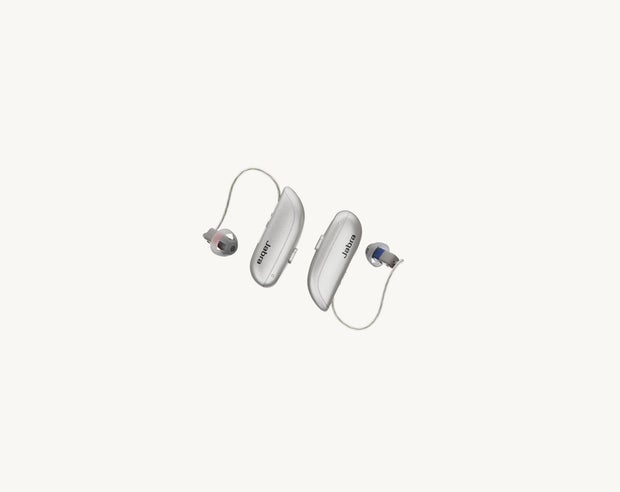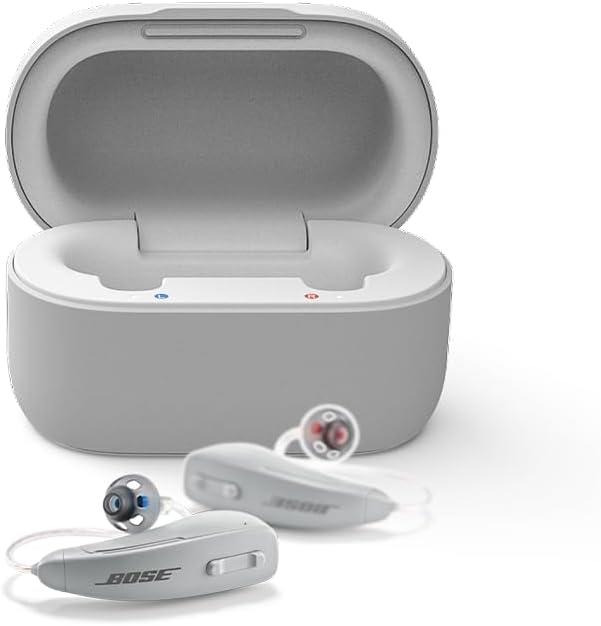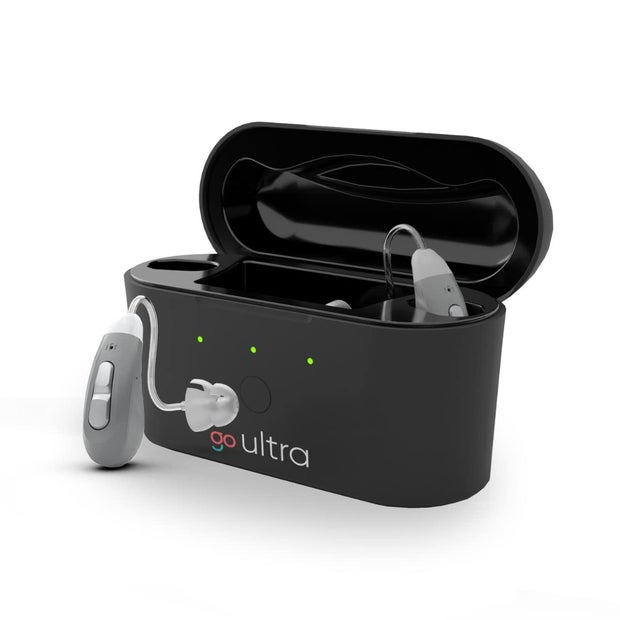CBS News
Best Bluetooth hearing aids in 2024

Jabra
Hearing loss can be a big roadblock to a happy and healthy life. Hearing aids can be life-altering in the best of ways — self-reported hearing loss has been associated with increased rates of depression and anxiety across the board. With hearing aid technology improving all the time, there’s never been a better time to invest in a new pair of hearing aids. One feature that’s worth looking at in many newer models is Bluetooth connectivity, which lets wearers listen to entertainment — TV shows, songs, podcasts — with ease.
With so many brands and hearing aid models to choose from, you might be wondering which is the best. Prescription hearing aids can be custom fit and pre-programmed by an audiologist, for example, while many over-the-counter hearing aids (OTC) are more affordable. One thing that hearing aid brands are working to perfect is seamless Bluetooth compatibility.
Below, we highlight the best Bluetooth hearing aids — OTC and prescription models alike — to help you find the perfect pair for you.
What is the best Bluetooth hearing aid in 2024?
The best Bluetooth hearing aids make it easy to listen to your favorite shows, songs, podcasts and more on the go. If you want hearing aids that rival the latest and greatest wireless headphones, these are the top hearing aid brands of 2024 that should be on your list.
Check out the best hearing aids for Bluetooth streaming and wireless connectivity below.
Best overall: Jabra Enhance Select 300
Jabra
One of the best hearing aids you can buy online today is also our top pick for quality Bluetooth hearing aids. The Jabra Enhance Select 300 offers improved sound quality, an impressive battery life and a lightweight design.
With some OTC hearing aids, a common customer complaint you may come across is a flat or distorted sound quality. That’s not the case with Jabra’s smallest hearing aid model to date. This hearing aid rivals most prescription hearing aids, with decent sound boost and exceptional noise filtration features.
The Jabra Enhance Select also offers high-quality Bluetooth streaming for TV, music, podcasts and more. As Jabra’s newest and most impressive model, the Enhance Select does come with a price tag that starts at $1,795.
Pros:
- Seamless Bluetooth compatibility that can be managed and adjusted via the Jabra Enhance mobile app.
- Top-notch sound amplification and background noise reduction features that justify a higher-than-average price tag.
Cons:
- High price for OTC hearing aids — check our runner up pick below for a more budget friendly pick from Jabra.
Budget-friendly runner up: Jabra Enhance Plus
Intrigued by Jabra’s impressive hearing aid tech but less interested in paying over $1,500 for a single pair of hearing aids? Consider the Jabra Enhance Plus hearing aid: Available for $800, the Plus is our unflinching choice for best OTC hearing aids thanks to a sleek design, 10-hour battery life, crisp speech amplification, and yes — fully compatible Bluetooth connectivity.
Unlike many prescription hearing aids that can cost thousands of dollars a pair, these hearing aids — Jabra’s first OTC model — offer impressive sound quality and features for a great price that’s under $1,000.
Most comfortable fit: Lexie B2 Plus
Lexie via Amazon
Fully in-ear hearing aids can be great for convenience and a truly seamless look, but if you want something that balances comfort with functionality — look no further than the Lexie B2 plus hearing aid.
Powered by Bose, this OTC hearing aid offers prescription-grade sound quality and audio design without the high prices that typically come with prescription hearing aids.
The sound quality here is exceptional, thanks to sharp background noise cancellation and crisp sound amplification. The design of these hearing aids offers the best of both worlds when it comes to in-ear vs. behind-ear styles: the receiver-in-canal build means all that impressive tech sits in a casing behind your ear while the earbud portion sits snugly in the canal. If you want a hearing aid that won’t get loose or grow uncomfortable after long periods of use, this is the device for you.
You can buy a pair of Lexie B2 Plus hearing aids powered by Bose from Amazon or Lexie directly today for $999.
Pros:
- A comfortable design that isn’t too small for button control nor too big to be comfortable for long periods of use.
- Exceptional sound quality all around.
Cons:
- While the price is low compared to most prescription models, it’s still higher than many of its OTC hearing aid competitors.
Cutting edge tech: Starkey Genesis AI
Starkey
Launched in February of 2023, the Genesis AI is the latest and greatest hearing aid offering from Starkey. AI, or artificial intelligence, has been powering hearing aid devices since 2018 (with Starkey’s Livio AI hearing aid model).
The Genesis AI hearing aid aims to minimize the number of times you need to make manual adjustments by improving your hearing automatically. This is backed by sound technology that tracks adjustments and gauges incoming sounds in real time. These AI-powered hearing aids then use this information to pick certain listening modes (restaurant mode, TV mode, etc.) or make adjustments on the fly so that you don’t have to.
Along with features like crisp Bluetooth connectivity, health tracking, and the best battery life we’ve seen yet in our reviews (51 hours on a single charge according to Starkey), this hearing aid already earned its spot on our list. But it’s also the only hearing aid available right now that offers fall detection and language translation services.
This new and innovative hearing aid is available starting at around $2,400 per pair, but prices can vary considerably from one retailer to the next.
Pros:
- Robust sound amplification features make this hearing aid worth the high price tag.
- AI-powered “deep neural network” feature learns what sound programs and adjustments you need to offer an easy and automated listening experience.
- Unmatched battery life that lasts longer than 50 hours on a single charge.
Cons:
- Starkey mobile app may be confusing and overwhelming to new users.
Best sound quality: Phonak Audéo Lumity
Phonak
Hearing aid technology is always improving, and if you want to be at the forefront of it all where all that cutting edge technology is, we recommend the latest flagship hearing aid by Phonak, the Audéo Lumity. This hearing aid has several new and impressive features over the Phonak Audéo Paradise such as patented speech-focused tech for front-facing conversations and improved hearing from the sides and back.
This hearing aid offers seamless Bluetooth integration for both iOS and Android devices, as well as fitness-tracking features like step counts via the MyPhonak mobile app. Couple this with a long-lasting battery charge and high quality sound, and you have a great hearing aid for anyone with moderate to severe hearing loss.
As a prescription hearing aid, the Phonak Lumity is available in four technology tiers, with more functionalities (and a higher price) tied to higher ones. These include L30 (essential), L50 (standard), L70 (advanced), and L90 (premium).
Prices start at around $1,800 for the lowest tier, the Lumity L30 hearing aid.
Pros:
- Some of the best audio quality we’ve seen, thanks to the latest hearing aid tech for amplifying incoming sounds and conversations.
- Universal Bluetooth technology that can stream phone calls, music, podcasts and more — and doesn’t lose its connection intermittently like some other budget OTC hearing aids.
Cons:
- Some negative customer reviews highlight poor usability with myPhonak mobile app, which may take some getting used to.
Most affordable: Go Hearing Ultra OTC
Go Hearing
Looking for a comfortable behind-the-ear hearing aid that ensures a secure fit all day long? The Go Hearing Ultra OTC hearing aid is another super comfortable hearing aid with Bluetooth capabilities, but that’s not all: It’s also the cheapest hearing aid on our list.
This wireless hearing aid comes with several standout features besides full Bluetooth streaming capability including hands-free calls and a whopping 20-hour battery life.
Thanks to an included measuring tool, this hearing aid is also easily fitted and configured on your own — no visits to an audiologist or specialist required if you’d prefer a DIY approach.
Pros:
- Comfortable and lightweight, especially for behind-the-ear hearing aids, which can sometimes be on the bulkier side.
- Impressive 20-hour battery life for OTC hearing aids.
Cons:
- Sound performance may not be as robust as other hearing aids.
- No mobile app, so daily adjustments are limited to the device’s buttons.
How we compared the best Bluetooth hearing aids of 2024
For a closer look at how we rate certain products and services, here is what we prioritized while looking at the best hearing aids for wireless connectivity:
- Affordability: We looked plenty of budget-friendly OTC devices to make sure we only highlight the highest-quality hearing aids.
- Tech features: Alongside the obvious (full Bluetooth streaming capabilities), we paid attention to features like consistent sound quality and crisp noise amplification to make sure we highlight the best of the best.
- Sound quality: We looked for important features like deep background noise cancellation and crisp speech amplification.
- Customer reviews: All of our hearing devices hold a four-star review or higher from happy customers just like you.
- Comfort: We paid attention to the design, shape, and fit of each hearing aid to ensure only the most comfortable hearing aids made the list.
CBS News
Mike Tyson says he has “no regrets” after losing boxing match to Jake Paul

Despite losing his boxing match to Jake Paul, Mike Tyson in a social media post Saturday said he had “no regrets” to getting “in ring one last time.”
The boxing legend was defeated by social media star Jake Paul in a highly anticipated fight on Friday night with an age difference of over three decades between the two contenders.
Netflix said Saturday that 60 million households worldwide tuned in to watch the match. The two fighters went eight full rounds, with each round two minutes long. Paul defeated Tyson by unanimous decision and the 27-year-old upset boxer and 58-year-old former heavyweight champion hugged afterward.
Paul was expected to earn about $40 million from the fight, and Tyson was expected to take around $20 million for the fight, according to DraftKings and other online reports.
Getty Images
Tyson said on his social media that “this is one of those situations when you lost but still won. I’m grateful for last night.”
The fight almost didn’t happen after Tyson experienced an ulcer flare-up while on a plane in March. He addressed his illness Saturday, writing that he “almost died in June.” He said he had eight blood transfusions and “lost half my blood and 25lbs in hospital and had to fight to get healthy to fight so I won.”
Tyson retired from boxing in 2005 after a 20-year career. He last fought in a 2020 exhibition match against former four-division world champ Roy Jones Jr.
“To have my children see me stand toe to toe and finish 8 rounds with a talented fighter half my age in front of a packed Dallas Cowboy stadium is an experience that no man has the right to ask for. Thank you,” he said.
Alex Sundby and
contributed to this report.
CBS News
In their final meeting, Xi tells Biden he is “ready to work with a new administration”
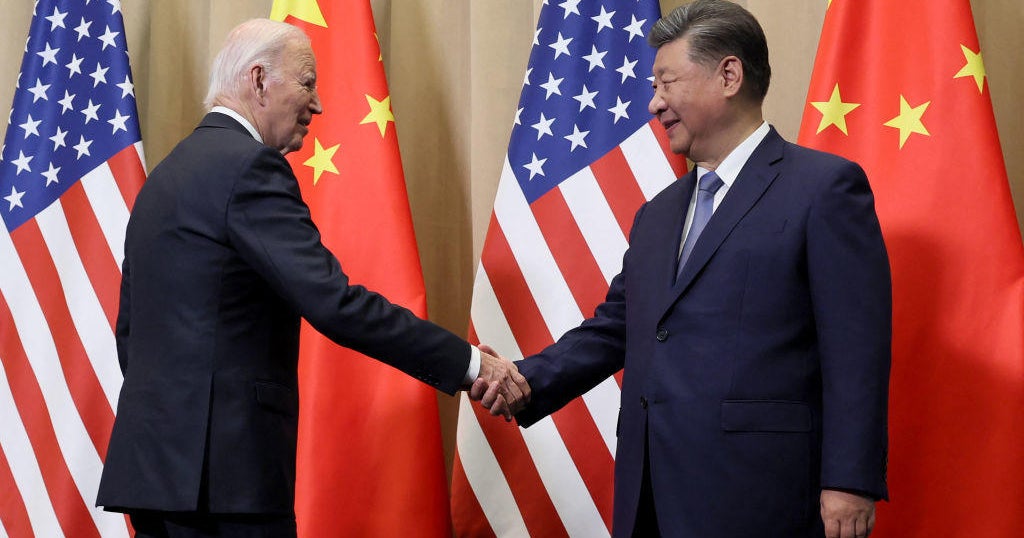
In their final meeting, China’s leader Xi Jinping told U.S. President Biden that his nation was “ready to work with a new administration,” as President-elect Donald Trump prepares to take over.
The two leaders gathered Saturday on the sidelines of the annual Asia-Pacific Economic Cooperation summit. Mr. Biden was expected to urge Xi to dissuade North Korea from further deepening its support for Russia’s war on Ukraine. It marked their first in-person meeting since they met in Northern California last November.
Without mentioning Trump’s name, Xi appeared to signal his concern that the incoming president’s protectionist rhetoric on the campaign trail could send the U.S.-China relationship into another valley.
“China is ready to work with a new U.S. administration to maintain communication, expand cooperation and manage differences so as to strive for a steady transition of the China-U.S. relationship for the benefit of the two peoples,” Xi said through an interpreter.
LEAH MILLIS/POOL/AFP via Getty Images
Mr. Biden, meanwhile, spoke in broader brushstrokes about where the relationship has gone and reflected not just on the past four years, but on their long relationship.
“Over the past four years, China-U.S. relations have experienced ups and downs, but with the two of us at the helm, we have also engaged in fruitful dialogues and cooperation, and generally achieved stability,” he said.
Mr. Biden and Xi, with top aides surrounding them, gathered around a long rectangle of tables in an expansive conference room at Lima’s Defines Hotel and Conference Center.
There’s much uncertainty about what lies ahead in the U.S.-China relationship under Trump, who campaigned promising to levy 60% tariffs on Chinese imports.
Bobby Djavaheri, president of Los Angeles-based Yedi Houseware Appliances — which manufactures its products in China — told CBS News in an interview this week that such tariffs “would decimate our business, but not only our business. It would decimate all small businesses that rely on importing.”
Trump has also proposed revoking China’s Most Favored Nation trade status, phasing out all imports of essential goods from China and banning China from buying U.S. farmland.
Already, many American companies, including Nike and eyewear retailer Warby Parker, have been diversifying their sourcing away from China. Shoe brand Steve Madden says it plans to cut imports from China by as much as 45% next year.
White House national security adviser Jake Sullivan said Biden administration officials will advise the Trump team that managing the intense competition with Beijing will likely be the most significant foreign policy challenge they will face.
It’s a big moment for Mr. Biden as he wraps up more than 50 years in politics. He saw his relationship with Xi as among the most consequential on the international stage and put much effort into cultivating that relationship.
Mr. Biden and Xi first got to know each other on travels across the U.S. and China when both were vice presidents, interactions that both have said left a lasting impression.
“For over a decade, you and I have spent many hours together, both here and in China and in between. And I think we’ve spent a long time dealing with these issues,” Mr. Biden said Saturday.
But the last four years have presented a steady stream of difficult moments.
The FBI this week offered new details of a federal investigation into Chinese government efforts to hack into U.S. telecommunications networks. The initial findings have revealed a “broad and significant” cyberespionage campaign aimed at stealing information from Americans who work in government and politics.
U.S. intelligence officials also have assessed China has surged sales to Russia of machine tools, microelectronics and other technology that Moscow is using to produce missiles, tanks, aircraft and other weaponry for use in its war against Ukraine.
And tensions flared last year after Mr. Biden ordered the shooting down of a Chinese spy balloon that traversed the United States.
CBS News
Trump selects Liberty Energy CEO Chris Wright as secretary of Energy
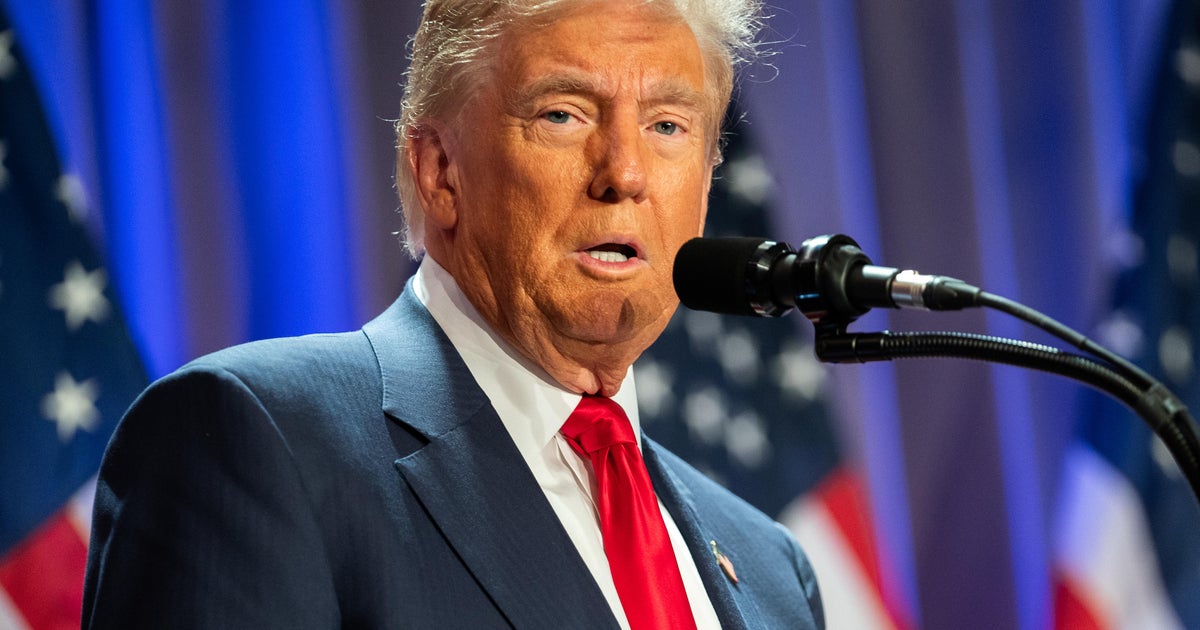
President-elect Donald Trump has selected Chris Wright, a campaign donor and fossil fuel executive, to serve as energy secretary in his upcoming, second administration.
CEO of Denver-based Liberty Energy, Wright is a vocal advocate of oil and gas development, including fracking, a key pillar of Trump’s quest to achieve U.S. “energy dominance” in the global market.
Trump also said in a statement Saturday that Wright will serve on the newly-created National Energy Council, which will be chaired by North Dakota Gov. Doug Burgum, Trump’s selection for secretary of the Interior.
Burgum will oversee a panel that crosses all executive branch agencies involved in energy permitting, production, generation, distribution, regulation and transportation, Trump said in a previous statement.
Wright has been one of the industry’s loudest voices against efforts to fight climate change and could give fossil fuels a boost, including quick action to end a year-long pause on natural gas export approvals by the Biden administration.
Wright also has criticized what he calls a “top-down” approach to climate by liberal and left-wing groups and said the climate movement around the world is “collapsing under its own weight.”
Consideration of Wright to head the administration’s energy department won support from influential conservatives, including oil and gas tycoon Harold Hamm.
Hamm, executive chairman of Oklahoma-based Continental Resources, a major shale oil company, is a longtime Trump supporter and adviser who played a key role on energy issues in Trump’s first term.
Hamm helped organize an event at Trump’s Mar-a-Lago resort in April where Trump reportedly asked industry leaders and lobbyists to donate $1 billion to Trump’s campaign, with the expectation that Trump would curtail environmental regulations if re-elected.
The Energy Department is responsible for advancing energy, environmental and nuclear security of the United States. The agency is in charge of maintaining the country’s nuclear weapons, oversees 17 national research laboratories and approves natural gas exports, as well as ensuring environmental cleanup of the nation’s nuclear weapons complex. It also promotes scientific and technological research.
Republican Sen. John Barrasso, who is expected to become chairman of the Senate Energy and Natural Resources Committee, said Trump promised bold choices for his Cabinet, and Wright’s nomination delivers.
“He’s s an energy innovator who laid the foundation for America’s fracking boom. After four years of America last energy policy, our country is desperate for a secretary (of energy) who understands how important American energy is to our economy and our national security,″ Barrasso said of Wright, adding: “Wright will help ensure America remains committed to an all-of-the-above energy policy that puts American families first.”
Thomas Pyle, president of the American Energy Alliance, a conservative group that supports fossil fuels, said Wright would be “an excellent choice” for Energy secretary. Pyle led Trump’s Energy Department’s transition team in 2016.
Liberty is a major energy industry service provider, with a focus on technology. Wright, who grew up in Colorado, earned undergraduate degree at MIT and did graduate work in electrical engineering at the University of California-Berkeley and MIT. In 1992, he founded Pinnacle Technologies, which helped launch commercial shale gas production through hydraulic fracturing, or fracking.
He later served as chairman of Stroud Energy, an early shale gas producer, before founding Liberty Resources in 2010.



